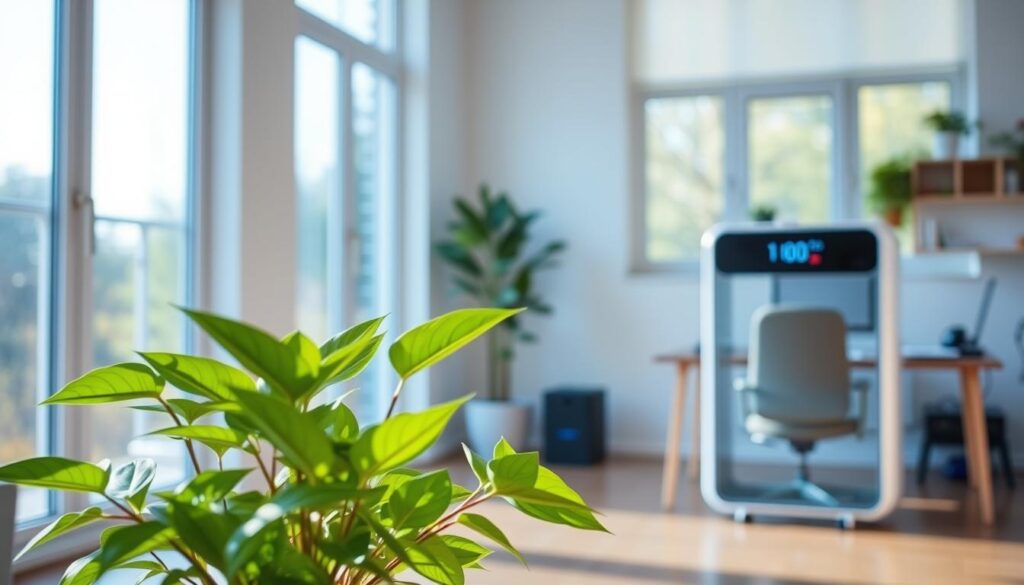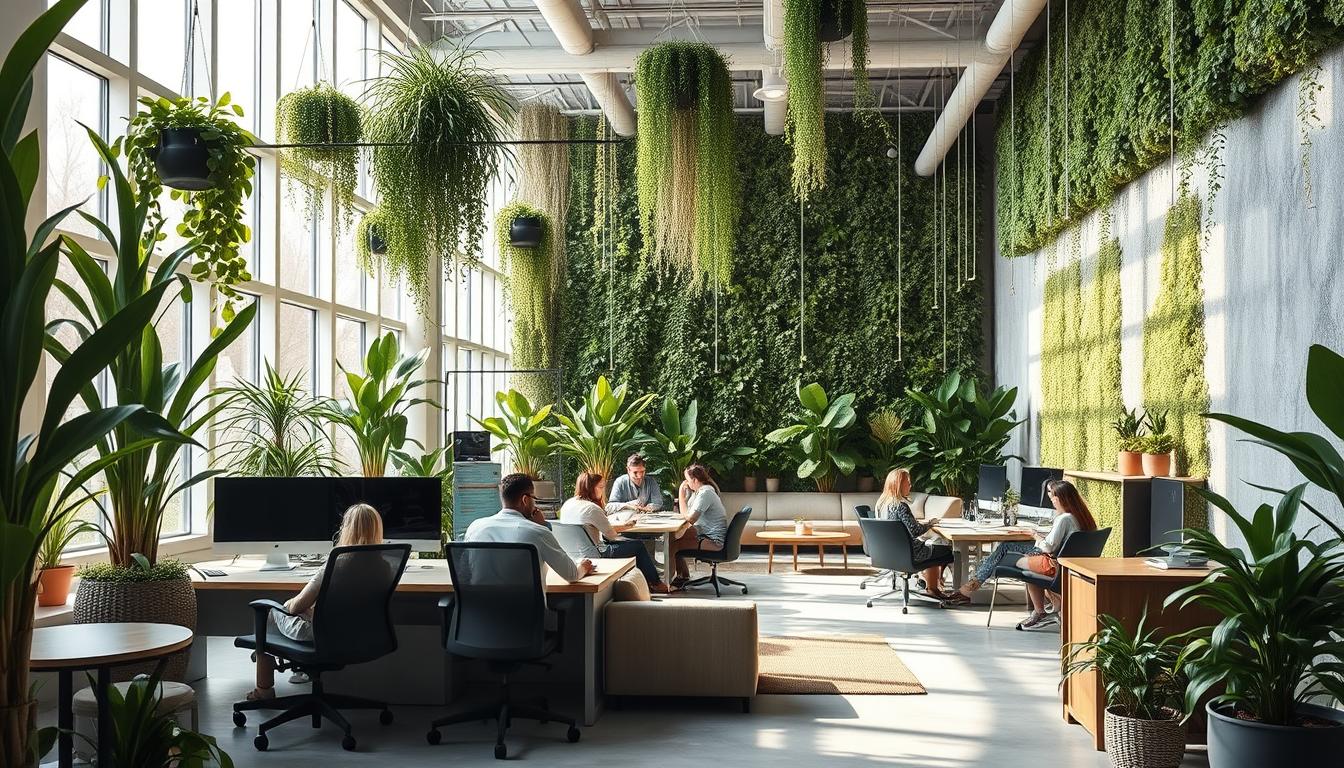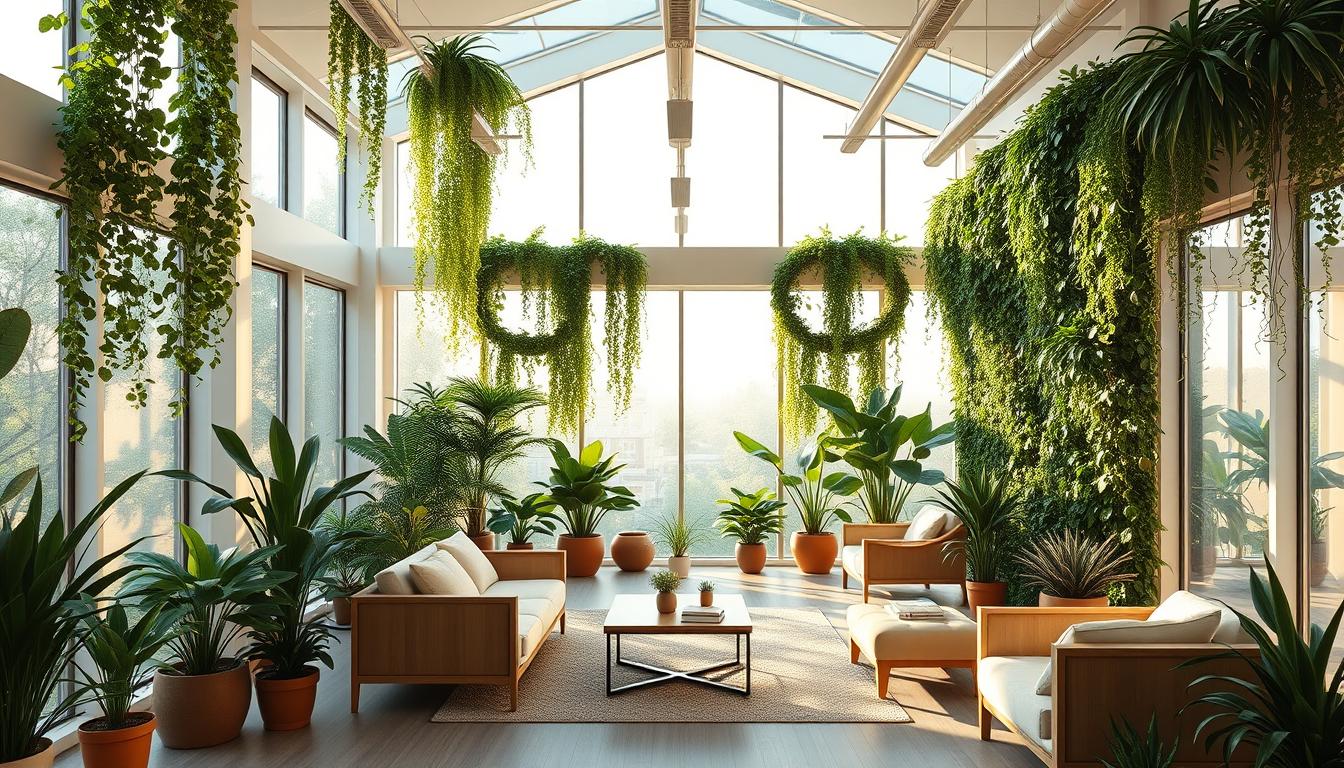Today, making our air cleaner is very important, especially because we stay inside more. Indoor plants do more than look good; they help lower CO₂ and make our air better. This article will talk about why having plants inside can be good for the planet and clean the air. By picking the right plants, you can make the inside of your home healthier, more comfortable, and better for everyone.
The Importance of Indoor Air Quality
Indoor air quality (IAQ) is key for our well-being. Poor IAQ can lead to health problems like breathing issues, headaches, and tiredness. It often comes from construction materials, furniture, and daily activities.
Energy-efficient buildings have brought IAQ into focus. Tight building methods save energy but can keep bad air inside. It’s important to clean the air to keep people healthy.
Using air purifiers is vital. Also, houseplants can help clean the air. Knowing about IAQ and its health effects lets us make our homes healthier.

Understanding CO₂ and Its Effects on Health
Carbon dioxide (CO₂) is a common indoor pollutant, mostly coming from activities like breathing, cooking, and heating. Knowing where CO₂ comes from is key to understanding its health effects. High CO₂ levels can be harmful to our health. Studies show a clear link between higher CO₂ and worse cognitive performance.
When people are exposed to a lot of CO₂, they report lower attention spans and problem-solving skills. This issue is more than just feeling uncomfortable; long-term exposure can lead to serious cognitive issues. To protect public health, there are guidelines for safe indoor CO₂ levels.
It’s crucial to understand how CO₂ affects us to improve the air we breathe indoors. More people now realize the need to keep an eye on CO₂ levels at home and work.
How Indoor Plants Purify Air
Indoor plants help clean the air, making our indoor spaces healthier. They take in carbon dioxide and make oxygen through photosynthesis. This lowers CO₂ levels indoors and improves air quality.
Plant respiration also purifies air. During the day, plants absorb CO₂ and release oxygen. At night, they still improve air quality, even though it’s at a slower rate.
Indoor plants are great at absorbing harmful substances, like formaldehyde and benzene. These substances are in many household products. Some plants are particularly good at cleaning these pollutants, according to NASA studies.
Microorganisms in potting soil also help clean the air. They break down bad chemicals. This helps plants make indoor air cleaner.
Benefits of CO₂ Level Reduction with Indoor Vegetation
Having plants indoors cuts CO₂ and is great for health. They make breathing easier and lessen the chance of getting sick. This creates a healthier place to live.
Plants indoors help us de-stress. They make us feel calm by lowering anxiety. This is very helpful in busy work environments.
Plants clean the air, which is good for our health and helps us work better. When we think clearer, we can do our tasks more effectively. This is why plants are important in offices.
Keeping plants inside is also good for the earth. They clean the air, helping fight against pollution. When we add plants to our rooms, we’re helping the planet and making our spaces look better.
Top Indoor Plants for Improving Air Quality
Choosing the right indoor plants can make your home or office air cleaner. Some plants are really good at purifying the air. The Spider Plant, Peace Lily, and Bamboo Palm are great at taking out bad pollutants from the air.
Spider Plant: A Breath of Fresh Air
The Spider Plant is famous for improving air quality. It’s really good at getting rid of harmful substances like formaldehyde and xylene. This hardy plant is easy to look after. It likes bright, indirect light and slightly damp soil. It’s great for making your air healthier.
Peace Lily: A Natural Comfort
The Peace Lily is beautiful and helps clean the air. It takes out pollutants such as ammonia, benzene, and trichloroethylene. This plant does well in low light and needs regular watering. It keeps your air pure and your space looking good.
Bamboo Palm: The Air-Purifying Powerhouse
The Bamboo Palm is top-notch for air quality. It gets rid of toxins and adds moisture to the air. This plant loves bright, indirect sunlight and slightly moist soil. Adding a Bamboo Palm to your area means enjoying fresher air and a healthier place.
Plant Care Tips for Optimal Air Quality
To make your indoor plants clean the air well, care for them correctly. Knowing how to water, keep up the soil, and light them right helps a lot. These tips will keep your indoor garden in top shape.
Watering and Soil Maintenance
Watering your plants the right way keeps them healthy and helps clean the air. Here are tips for watering:
- Before watering, check if the soil is a bit dry.
- Use pots that let water out to stop roots from rotting.
- Know your plant’s needs; succulents need less water than others.
Good soil matters a lot for healthy plants. Pick a potting mix that drains well. Change your soil yearly so plants get all the nutrients they need.
Providing Adequate Light
Plants need the right light to grow and clean the air. Each plant needs different light:
- Keep plants by south or west windows for the most sun.
- Use artificial lights for plants that don’t need much sun.
- Turn pots now and then so plants grow evenly.
Right light levels make your plants strong and better at purifying air.
Customizing Your Indoor Garden for CO₂ Reduction
When you set up an indoor garden, think about the plants and where they’ll go. Choose plants wisely to clean the air best. Pick ones that look good and help lower CO₂ in your home.
- Diversity: Incorporate a range of plants, such as Spider Plants and Peace Lilies, to tackle various pollutants.
- Grouping: Place plants in clusters to create a microclimate that encourages air circulation and enhances filtration.
- Light Conditions: Identify areas with suitable lighting and position plants accordingly to promote their growth and air-cleaning capabilities.
Adding decor can also help your indoor garden. Use planters that let roots breathe or set up vertical gardens to save space. This not only cuts down CO₂ but also makes your place look great.
Comparing Plants and Air Purifiers for Air Quality
The debate around plants vs air purifiers for indoor air quality is common. Each method offers distinct pros and cons that impact how we live. Knowing these differences helps us choose the best way to enhance our indoor space.
Plants add beauty and clean the air naturally. They take in CO2 and give off oxygen, which makes our surroundings healthier. Yet, they can only remove a few pollutants and need regular care like water and trimming. They also make us feel less stressed and happier.
Air purifiers, however, use filters to clean the air mechanically. They’re great at capturing allergens, dust, and harmful particles. Their cleaning ability often beats that of plants. But they need power to work and filter changes, which costs money over time.
Using plants and air purifiers together offers the best of both worlds. Plants make our rooms look good and feel calming. Air purifiers quickly clean harmful particles out of the air. This combo creates a welcoming and healthy indoor environment.
Scientific Research on Plants and Air Pollution
Many studies show that indoor plants improve air quality and lower pollutants like carbon dioxide (CO₂). NASA’s research stands out in this area. It shows how some plants can filter harmful substances from the air. This makes indoor air healthier.
Nasa’s Study on Air-Purifying Plants
NASA looked into how indoor plants clean the air. They tested how well certain plants could remove harmful chemicals. Their findings? Plants like the spider plant and peace lily do more than look good. They help clean the air in our homes.
Room Studies Showing the Impact on CO₂ Levels
Other studies have looked at plants and CO₂ levels in rooms. These experiments in controlled settings showed that plants reduce CO₂. This highlights why it’s good to have plants in homes and offices. Adding plants helps make the air fresher and healthier to breathe.
Conclusion
Adding houseplants to your space is a great way to reduce CO₂ and boost your health. Greenery cleans the air and makes you feel better. It brings down harmful CO₂, making your space fresh and lively.
Good air inside is key to feeling well. Plants like the Spider Plant, Peace Lily, and Bamboo Palm are great helpers. Adding these plants makes your space bright and helps your mind and body.
Using indoor plants for a healthier life is a smart move. It’s good for you and the earth. Make your place green for better health and a link with nature.



